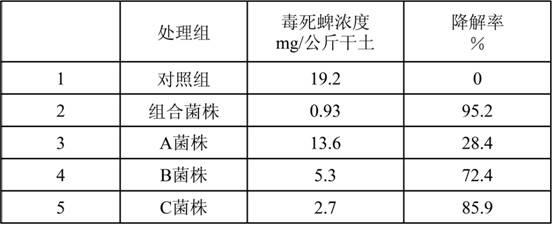Multi-strain composition for efficiently degrading environmental organophosphorus pesticide residues
A technology of organophosphorus pesticides and compositions, applied in the field of environmental bioengineering, can solve the problems of slow degradation of bacterial strains, lack of rapid degradation, and difficulty in rapid removal, etc., and achieve the effect of removing pollution
- Summary
- Abstract
- Description
- Claims
- Application Information
AI Technical Summary
Problems solved by technology
Method used
Image
Examples
Embodiment 1
[0026] Example 1: Degradation of multi-strain composition to 100mg / L high concentration pesticide chlorpyrifos in water sample
[0027] 1. Bacteria solution preparation
[0028] Prepare A bacteria solution, B bacteria solution and C bacteria solution respectively:
[0029] (1), strain A is Rhodococcus rhodococcus ( Rhodococcus rhodochrous ) R-D3 strain,
[0030] (2), B strain is Microacidophilus Stenotrophomonas ( Stenotrophomonas acidaminiphila ) G1 strain,
[0031] (3), C strain is Copperophilus Taiwan ( Cupriavidus taiwanensis ) X1 strain,
[0032] Prepare LB liquid culture medium, aseptically inoculate a ring of bacteria from the slant of A strain, B strain and C strain into LB liquid medium; place the inoculated medium at constant temperature Cultivate in a shaking incubator, the culture conditions are: 30°C, 120 rpm, and culture for 24 hours; the cell concentration is 5.0×10 9 / mL of A bacteria solution, cell concentration 8.0×10 9 / mL of B bacteria solution an...
Embodiment 2
[0050] Example 2: Degradation of 50mg / L high concentration pesticide chlorpyrifos in water sample by suspension cell multi-strain composition
[0051] 1. Bacteria solution preparation
[0052] Prepare A bacteria solution, B bacteria solution and C bacteria solution respectively:
[0053] Aseptically inoculate a loop of bacteria from the slant of strain A, strain B and strain C into LB liquid medium; culture the inoculated medium in a constant temperature shaking incubator, The culture conditions are: 30°C, 120 rpm, and culture for 30 hours; the cell concentration is 6.0×10 9 / mL of A bacteria solution, cell concentration 9.0×10 9 / mL of B bacteria solution and cell concentration 7.0×10 9 / mL of C bacteria solution, the temperature is 4 ℃ for later use.
[0054] Obtain the cells in the bacterial liquid by centrifugation, centrifuge at a speed of 5000 rpm, and centrifuge for 20 minutes; discard the supernatant, and suspend the centrifuged precipitated cells with 100 mL of 0...
Embodiment 3
[0069] Example 3: Degradation of 20mg / L low-concentration pesticide chlorpyrifos in soil by solid multi-strain composition
[0070] 1. Bacteria solution preparation
[0071] The preparation of A bacteria solution, B bacteria solution and C bacteria solution is the same as above, and the cell concentration is 5.0×10 respectively. 9 / mL of A bacteria solution, cell concentration 8.0×10 9 / mL of B bacteria solution and cell concentration 6.0×10 9 / mL of C bacteria solution.
[0072] 2. Preparation of solid-state multi-strain combination bacteria
[0073] Take 100mL of A bacterial solution, 50mL of B bacterial solution and 50mL of C bacterial solution, mix them evenly according to the volume ratio of 2:1:1, add 250g of solid adsorbent peat, and mix well to obtain a solid multi-strain composition; temperature Store at 4°C for later use.
[0074] 3. Degradation of pesticide chlorpyrifos in soil by multi-strain composition
[0075] Take 500g of air-dried soil and put it in a p...
PUM
 Login to View More
Login to View More Abstract
Description
Claims
Application Information
 Login to View More
Login to View More - R&D
- Intellectual Property
- Life Sciences
- Materials
- Tech Scout
- Unparalleled Data Quality
- Higher Quality Content
- 60% Fewer Hallucinations
Browse by: Latest US Patents, China's latest patents, Technical Efficacy Thesaurus, Application Domain, Technology Topic, Popular Technical Reports.
© 2025 PatSnap. All rights reserved.Legal|Privacy policy|Modern Slavery Act Transparency Statement|Sitemap|About US| Contact US: help@patsnap.com



